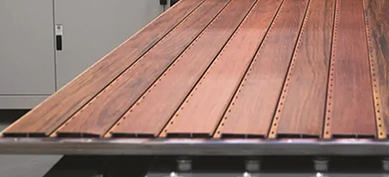In the realm of architectural acoustics, specifying the right materials is paramount to the success of a project. Among the various solutions available, WPC acoustic wall panels have emerged as a prominent choice for professionals seeking a blend of performance, durability, and aesthetic appeal. However, with a growing market comes a proliferation of products with varying technical specifications. For wholesalers, buyers, and specifiers, navigating these specifications is critical. The most frequently encountered, and often most misunderstood, metric is the Noise Reduction Coefficient, or NRC.
Understanding the Core Product: What Are WPC Acoustic Wall Panels?
Before delving into the specifics of acoustic performance, it is essential to understand the fundamental nature of the product. Wpc acoustic wall panels are engineered composites designed to manage sound reverberation within a space. The term “WPC” stands for Wood Plastic Composite, which precisely describes its composition. These panels are typically manufactured by combining wood flour or fibers with thermoplastics—such as polyethylene or polyvinyl chloride—and a series of specialized additives. This mixture is then heated and formed into panels through a process like extrusion or compression molding.
The resultant product inherits the best qualities of its constituent materials. From wood, it gains a degree of rigidity, a natural aesthetic, and workability. From plastic, it acquires significant resistance to moisture, rot, and insects. This combination makes WPC acoustic panels exceptionally suited for environments where traditional wood or fabric panels might fail, such as in swimming pool natatoriums, humid climates, restaurants, kitchens, or exterior shaded areas. Furthermore, the composite nature of WPC allows for a high degree of customization in terms of color, texture, and size, making it a versatile tool for interior designers and architects. The acoustic performance is integrated through the panel’s design, which often includes perforations on the surface and a sound-absorbing core or backing material.
Decoding the NRC: The Science of Sound Absorption
The Noise Reduction Coefficient (NRC) is a standardized rating that provides a simple measure of a material’s ability to absorb sound energy that strikes it. It is a single-number index ranging from 0.00 to 1.00, though some high-performance products can exceed 1.00 when tested in a laboratory setting. An NRC of 0.00 signifies perfect reflection; all sound that hits the material bounces back into the room. Conversely, an NRC of 1.00 signifies perfect absorption; all sound energy that hits the material is absorbed and not reflected.
It is crucial to understand what NRC is not. It is not a measure of soundproofing or Sound Transmission Class (STC). NRC quantifies how much sound is absorbed within a room to reduce echo and reverberation—how “live” or “dead” a room sounds. STC, on the other hand, measures how well a partition like a wall or door blocks sound from traveling between spaces. WPC acoustic wall panels are primarily designed for sound absorption (managing NRC), though their mass can contribute marginally to STC.
The NRC rating is an average of absorption coefficients at four mid-frequency test tones: 250Hz, 500Hz, 1000Hz, and 2000Hz. These frequencies cover the critical range of human speech and many everyday noises. The testing is conducted in a reverberation room according to strict standards, such as ASTM C423. This ensures that ratings are consistent and comparable across different products and manufacturers.
The Goldilocks Question: What is the “Right” NRC Rating?
The central question for any buyer is: what NRC rating should I look for? The answer, as with many engineering questions, is not a single number but depends entirely on the intended application. The goal is to find a panel that is “just right” for the specific acoustic environment it will inhabit.
Moderate Performance (NRC 0.50 - 0.70): This range is suitable for spaces where some acoustic control is desired, but the primary requirements may be aesthetic durability or moisture resistance. Panels in this range will take the sharp edge off a noisy room but will not create a profoundly quiet environment. They are often adequate for large, open-plan offices with other soft furnishings, hotel corridors, or the perimeter of a gymnasium. For buyers, these panels represent a solid, cost-effective entry point for general use.
High Performance (NRC 0.70 - 0.90): This is the sweet spot for the majority of commercial and institutional applications where clear communication and noise control are priorities. WPC acoustic wall panels in this range are highly effective at absorbing the frequencies of human speech and other common noises. They are the recommended choice for:
- Classrooms and lecture halls, where speech intelligibility is critical for learning.
- Open-plan offices and call centers, where reducing distracting conversational noise improves productivity and privacy.
- Restaurants and cafes, where controlling reverberation creates a more comfortable dining atmosphere without needing to shout.
- Healthcare facilities, such as waiting rooms and corridors, to reduce stress-inducing noise levels.
Very High / Superior Performance (NRC 0.90 and above): Panels achieving an NRC of 0.90 or higher are considered top-tier absorbers. These are specified for environments where acoustic excellence is non-negotiable and background noise must be minimized to the greatest extent possible. Applications include:
- Recording studios, podcast rooms, and home theaters, where any unwanted reverberation can compromise audio quality.
- Concert halls and performing arts centers, for off-stage areas and acoustic tuning.
- Libraries and museums, where a hushed atmosphere is essential to the experience.
- High-end boardrooms and conference rooms, ensuring perfect clarity in critical negotiations and presentations.
The following table provides a quick reference for matching NRC ratings to applications:
| Application Space | Recommended Minimum NRC | Performance Level | Primary Acoustic Goal |
|---|---|---|---|
| Recording Studios, Critical Listening | 0.90 - 1.00+ | Superior | Eliminate nearly all reverberation |
| Classrooms, Lecture Halls | 0.75 - 0.90 | High | Maximize speech intelligibility |
| Open-Plan Offices, Call Centers | 0.70 - 0.85 | High | Reduce distraction and improve privacy |
| Restaurants, Cafes | 0.70 - 0.80 | High | Create a comfortable ambiance |
| Hospitals, Healthcare Waiting Areas | 0.70 - 0.85 | High | Reduce stress-inducing noise |
| Hotels, Corridors | 0.60 - 0.75 | Moderate to High | Dampen noise transmission between spaces |
| Gyms, Swimming Pools | 0.50 - 0.70 | Moderate | Control echo and splash noise |
Beyond the Number: Other Critical Factors Influencing Performance
While the NRC rating is a vital starting point, an informed buyer must look beyond this single number. Several other factors interplay with the NRC to determine the real-world performance of WPC acoustic wall panels.
Panel Thickness and Density: Generally, thicker and denser panels, particularly those with a thick, porous core, are more effective at absorbing lower-frequency sounds (bass tones). A thin panel might have a good overall NRC but could perform poorly at 250Hz, allowing low rumbles to persist.
Perforation Pattern and Open Area: The pattern of holes on the surface of a WPC panel is not merely decorative; it is a key acoustic design feature. The percentage of open area (the total area of the holes versus the solid surface) and the size of the perforations directly influence which sound frequencies are most effectively absorbed. A variety of patterns are available to suit different aesthetic and acoustic needs.
Core and Backing Material: The true engine of sound absorption is often the material behind the rigid WPC face. Non-woven fabrics, fiberglass, or foam backings are commonly used to trap and dissipate sound energy. The quality, thickness, and specific type of this backing material are as important as the panel itself in achieving the published NRC rating.
Installation Method: Acoustic performance can be significantly enhanced or diminished by how the panels are installed. Mounting panels with an air gap between the panel and the wall substrate, rather than direct flat mounting, dramatically improves absorption, particularly across a broader range of frequencies. Using specialized acoustic wall panels mounting systems can elevate the effective performance of a panel beyond its laboratory-tested NRC.

 English
English Español
Español



